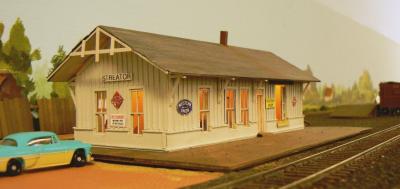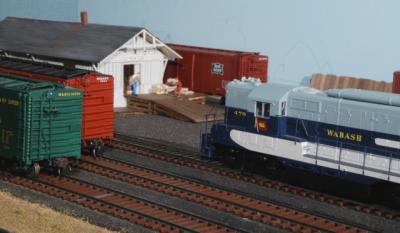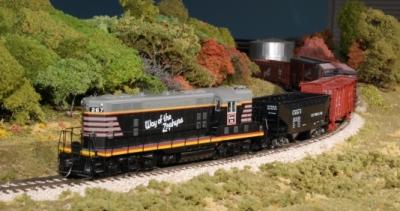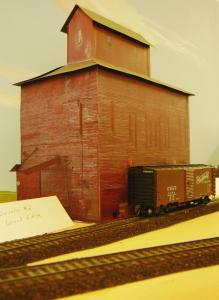A Visit to the Fox River Branch by Harold Krewer
It’s a crisp October evening in northern Illinois. The last rays of sunlight are hovering just above the tree line, adding a golden glow to the bonfire of color on the trees. Actually, a bonfire would feel good right about now….there’s a bit of a nip in the air thanks to a northwest wind. Your mind wanders back to the radio broadcast of the World Series you listed to earlier today, and you wonder if the heavily-favored Cleveland Indians, already down 3 games to none, will ever beat the New York Giants.
Except for the sounds of the wind in the trees and the gently flowing Fox River, all is quiet…but not for long. In the distance, the rhythm of internal combustion engines is heard. You nod and cock your ear to the south to listen, knowing that the real show is about to begin.
Growing ever louder and more strained, it becomes obvious that whatever task is at hand is taking everything they’ve got. Man, you say to yourself, he’s gotta have a big train today. Before long, the beam of an oscillating headlight appears, painting a swath of light across the sky and off the trees. Just as the ground under your feet begins to shake, the four locomotives (“motors” the railroad men call ‘em) of CB&Q Train 86 appear. The Engineer has them working all-out, straining to lift the heavy train behind them out of the Fox River valley.
Those cars trailing behind are destined for point far beyond here, carrying the raw materials needed to keep the nation’s industrial machine working. There are many different commodities on today’s train, but the overwhelming number of cars are carrying sand. Not just any sand, but high-grade silica sand, used for glassmaking, foundry casting and abrasive additives. Like run-of-the-mill sand though, silica sand is dense and heavy, and that is why the four Electro-Motive Division (EMD) F3’s on today’s train are struggling mightily to move it north.
Your vantage point is near a loose rail joint, and as the train passes you hear (and feel) each wheel slap that rail joint down, only to have it pop back up for more: thump-thump, thump-thump; thump-thump, thump-thump. As more of the train passes you, you note the cadence of this seemingly merciless beating is picking up, indicating Train 86 has won today’s battle against gravity.
After what seems like forever, the “waycar” (what they call cabooses on the CB&Q) shoots past, with a friendly wave from the cupola. As the twin red marker lights disappear around the curve and into the trees, the sounds of the river and the trees reclaim their prominence, not to be upstaged again until the morning, when southbound Train 85 will begin the cycle anew...
Page 2
You can’t go back to 1954 and relive those days, at least not in northern Illinois. You CAN, however, find this and other such scenes in, of all places, suburban Dallas, Texas, in the home of Eric Mumper. Eric grew up in Ottawa, IL and now lives in Plano, TX, where he (with some help from some local modelers) is building one hell of a CB&Q layout in a 24x60 second-floor addition over his garage.
Eric was very fortunate to have purchased his house “layout ready” from another modeler who had the addition built for his double-deck HO scale Colorado-themed layout.
He also inherited the previous owner’s VERY talented work group, who come over every Tuesday night to help work on or operate the layout!
Being from Ottawa, it should be no surprise to anyone that Eric is modeling the Q’s Montgomery-Streator line, commonly known as the Fox River Branch. Ottawa has always been the operational hub of this line, both for the CB&Q and Burlington Northern and for current operator Illinois Railway (part of the Genesee & Wyoming family).
Eric has chosen not to model the present day, nor the 1970s and 80s of his youth, but instead October 1954, which allows him to have passenger service (Aurora-Streator motorcar trains 133-134) and, with minimal fudging, the occasional O1a Mikado or steam switcher.
What follows are some photos and descriptions of Eric’s layout. We’ll start at Streator and generally work our way north, but you might want to refer to Eric’s employee timetable (separate file), which contains a trackplan, as we go:
Page 3
Here is the Wabash depot in Streator. Streator was a real active railroad town in the 1950s, with five railroads (AT&SF, CB&Q, GM&O, NYC and Wabash) operating into or through town, with significant interchange taking place. Streator also had two large glassmaking plants and several other heavy manufacturing businesses feeding traffic to the various railroads.
On Eric’s layout, four of the five railroads in Streator (AT&SF, CB&Q, GM&O, and 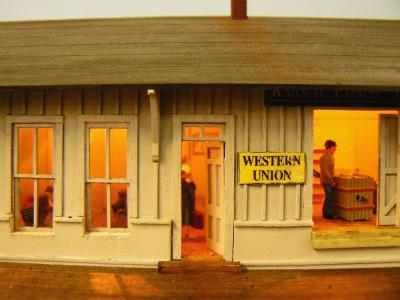 Wabash) are represented by “live” interchanges, and the NYC is a passive interchange but their main track is operational if so desired. The Wabash is perhaps the most extensive “foreign-road” operation, stretching from downtown southeast to the Smith-Douglass fertilizer plant. This exquisite model was built by one of his local modeler friends.
Wabash) are represented by “live” interchanges, and the NYC is a passive interchange but their main track is operational if so desired. The Wabash is perhaps the most extensive “foreign-road” operation, stretching from downtown southeast to the Smith-Douglass fertilizer plant. This exquisite model was built by one of his local modeler friends.
Streator features a full-time CB&Q switch job, currently held down by an 0-6-0, the only regular Q steam operation on the layout. Another operator is kept busy here operating trains into/out of Streator from staging on the “IV&N” (the Q’s Streator-LaSalle-Zearing line) and switching and making the interchange runs from the AT&SF (who jointly switches 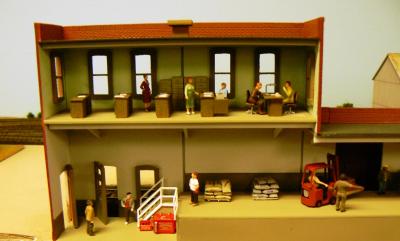 the Owens-Illinois glass plant with the Q), GM&O and Wabash.
the Owens-Illinois glass plant with the Q), GM&O and Wabash.
Another close-up view of the Wabash depot in Streator, showing the fully-detailed interior. The prototype depot in Streator stood until it burned down in the mid-1980s, long after Norfolk & Western (Wabash’s successor) abandoned the line. The office/warehouse building of Smith-Douglass in Streator is built along the front edge of the benchwork to show a fully-detailed interior toward the aisle.
Eric was kind enough to provide this photo from when the Wabash was in town (Photo courtesy Eric Mumper)
One of the runs the second Streator operator handles during the session is the “IV&N”, named for the original company that built the Streator-LaSalle-Zearing-Walnut line. Here the 267 brings the IV&N job out of staging with cars for
interchange at Streator.
Here is the elevator in Grand Ridge, IL north of Streator. Doesn’t it look nice? It’s just a few photographs of a wood elevator printed out and laminated to foam-core board. Pretty darn good for a “stand-in” buildings! Several similar "photo-core” structures are in process, including a model of the CB&Q Ottawa depot.
Page 4
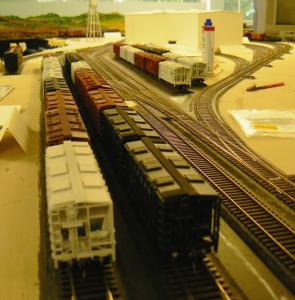 There aren’t many (actually, only one) photos of the Ottawa portion of the layout here, as it has very little scenery completed. Here’s the one shot I took , an overview of the “Seiberling Lead”, the joint RI-CB&Q industrial lead on Ottawa’s west side. The covered hoppers at left are spotted at Ottawa Silica for bulk sand loading, the tracks and mock-up building to the right represent the Libby-Owens-Ford glass plant. Beyond the water tower in the distance is the Rock Island’s Ottawa yard. The hills on the backdrop are actually across the aisle, but similar bluffs do exist in this part of Ottawa.
There aren’t many (actually, only one) photos of the Ottawa portion of the layout here, as it has very little scenery completed. Here’s the one shot I took , an overview of the “Seiberling Lead”, the joint RI-CB&Q industrial lead on Ottawa’s west side. The covered hoppers at left are spotted at Ottawa Silica for bulk sand loading, the tracks and mock-up building to the right represent the Libby-Owens-Ford glass plant. Beyond the water tower in the distance is the Rock Island’s Ottawa yard. The hills on the backdrop are actually across the aisle, but similar bluffs do exist in this part of Ottawa.
When Ottawa is done it will be quite remarkable as it will include a nearly full-size representation (all four spans) of the drawbridge over the Illinois River that will be the first thing you see as you climb the stairs into the layout room. Ottawa also features an extensive operating Rock Island presence, as both roads switch Ottawa Silica and Libby-Owens-Ford via the Seiberling Lead.
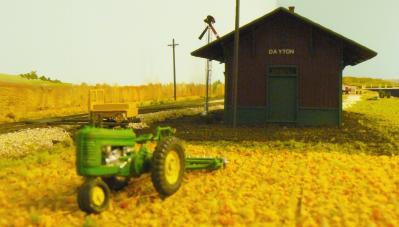 Ottawa keeps three operators busy, with one operating the RI (switch job and running pickup/setout trains to and from staging) and two on the Q (the Ottawa switch job and the “Roustabout”, which also switches in Ottawa and works up to Wedron and return).
Ottawa keeps three operators busy, with one operating the RI (switch job and running pickup/setout trains to and from staging) and two on the Q (the Ottawa switch job and the “Roustabout”, which also switches in Ottawa and works up to Wedron and return).
Here is the depot at Dayton, IL just north of Ottawa. While the depot is a faithful representation, the real Dayton is much more wooded and hilly than this, but when you have a bunch of native Texans working on your scenery (for free!), they tend to build what they know, which is flat and arid. Eric plans on revisiting this portion of the layout and conducting a “re-forestation” makeover once the major unfinished portions of the layout (Ottawa and Wedron) are in.
While we’re on the topic of faithful representation, we should note that Eric’s trackplan was based on the CB&Q’s track diagrams for the line. While space limitations did not permit modeling every town or a completely faithful representation, in several locations (like downtown Ottawa and Streator), the track arrangements are extremely faithful to the prototype. In the town of Wedron, the track arrangement is drawn from the CB&Q diagrams, but is “flipped” (i.e., a mirror image) from the prototype, to allow the large Wedron Silica Co. complex to be located along the backdrop.
Perhaps the most noticeable omission was Burgess Jct., where the branch line to Baker and Earlville (on the Chicago-Galesburg main) met the Streator line. Burgess Jct. had to go not only because there was not enough room between Wedron and Sheridan to fit it in, but also because the track arrangement would have had the wye jutting out into the aisle.
The omission of Burgess Jct. had one repercussion on the operating scheme: In 1954, the real Roustabout was a wayfreight that worked between Ottawa and Mendota via Burgess Jct., then northwesterly on the branch through Baker and Earlville to Mendota.
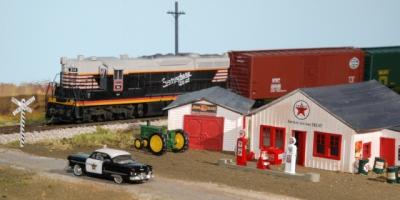 With no Burgess Jct. or line to Earlville, Eric’s Roustabout assists the Ottawa yard job with additional switching at Ottawa’s North Yard, then works a turn to Wedron where it switches the Wedron Silica plant and exchanges cars with the “Fox River Wayfreight”, an Eola (Aurora)-Wedron turn. Your author worked the Roustabout during his visit and had such a good time I forgot to take any photos! Fortunately, Eric had some photos from previous sessions when the same “motor”, SD7 # 314, was assigned:
With no Burgess Jct. or line to Earlville, Eric’s Roustabout assists the Ottawa yard job with additional switching at Ottawa’s North Yard, then works a turn to Wedron where it switches the Wedron Silica plant and exchanges cars with the “Fox River Wayfreight”, an Eola (Aurora)-Wedron turn. Your author worked the Roustabout during his visit and had such a good time I forgot to take any photos! Fortunately, Eric had some photos from previous sessions when the same “motor”, SD7 # 314, was assigned:
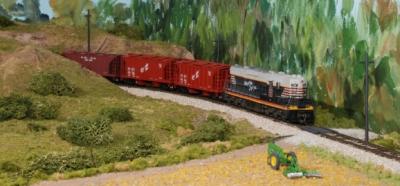 Extra 314 North (The Roustabout) enters the south edge of Dayton, IL on its way to Wedron. (Two photos this page courtesy of Eric Mumper)
Extra 314 North (The Roustabout) enters the south edge of Dayton, IL on its way to Wedron. (Two photos this page courtesy of Eric Mumper)
On another day, 314 has the Roustabout southbound leaving Wedron. While Wedron loading routed via Eola moves on the Fox River Wayfreight, other cars (cars bound for Chicago connections via Cicero as well as cars for Ottawa and Streator) are handled by the Roustabout to Ottawa for switching either to the Rock Island or blocked into the pickups for Cicero-Streator trains 85 and 86. This permits Train 86 to avoid stopping at Wedron to pick up before tackling the ruling grade just north of town.
Page 5
 The mainstays of freight service on the Fox River Branch were Cicero-Streator manifest trains 85 and 86. Here Steve Holding (a BNSF Dispatcher and another expatriated Illinoisan, originally from Aurora) has a long, heavy 86 northbound past the recently-harvested fields between Sheridan and Millington. That A-B-B-A set of F3s isn’t overkill: Not only were 85 and 86 high-tonnage trains, northbound Q trains faced a stiff climb out of the river bottoms north of Wedron. Just to the left out of frame the train is traversing the future location of the CB&Q bridge over the Fox River just outside Sheridan. Behind Steve you can see the south end of Wedron, where scenery work is just getting started. (Note that Texas steer on the right seems impressed by those “grayback” motors!)
The mainstays of freight service on the Fox River Branch were Cicero-Streator manifest trains 85 and 86. Here Steve Holding (a BNSF Dispatcher and another expatriated Illinoisan, originally from Aurora) has a long, heavy 86 northbound past the recently-harvested fields between Sheridan and Millington. That A-B-B-A set of F3s isn’t overkill: Not only were 85 and 86 high-tonnage trains, northbound Q trains faced a stiff climb out of the river bottoms north of Wedron. Just to the left out of frame the train is traversing the future location of the CB&Q bridge over the Fox River just outside Sheridan. Behind Steve you can see the south end of Wedron, where scenery work is just getting started. (Note that Texas steer on the right seems impressed by those “grayback” motors!)
 Train 86 roars through Millington, IL, where interchange is made with the 1.9-mile-long Illinois Midland, possibly the shortest common-carrier railroad the Q interchanged with. The IM was owned by the elevator in nearby Newark, IL and provided it with rail access.
Train 86 roars through Millington, IL, where interchange is made with the 1.9-mile-long Illinois Midland, possibly the shortest common-carrier railroad the Q interchanged with. The IM was owned by the elevator in nearby Newark, IL and provided it with rail access.
On Eric’s layout the IM is an active railroad, powered (like the prototype) by a single 0-4-0T, # 4. Interestingly, the real IM was a one-man operation, so when an operator on Eric’s layout runs the IM, it’s a completely prototypical full crew!
Pay no attention to the lettering on the depot that says “Hinckley”…obviously the B&B gang was lost (or drunk or both)  the day they painted the depot! As soon as they get the right stencils from the storehouse they’ll be back to take care of that.
the day they painted the depot! As soon as they get the right stencils from the storehouse they’ll be back to take care of that.
Here is a closeup of “downtown” Millington, showing the stock pen and the General Store which, like the prototype, doubles as the Odd Fellows hall (for those who don’t know, “I.O.O.F” stands for International Order of Odd Fellows, a fraternal organization).
A few feet down the benchwork from Millington we find the Newark elevator and team track at the other end of the Illinois Midland. Business appears to be good on the IM today!
Boarding the company blimp, we get another view of Train 86 in Millington, along with an overview of the village and the well-maintained right-of-way. Eric used Micro Engineering track and switches (codes 83 and 70) almost exclusively on this layout.
Here is the owner of the Fox River Branch and our host for this tour, Eric Mumper. In the background we see Steve Holding, fresh off Train 86 (see previous photo on Page 9), awaiting his next call to duty. Just to the left of Eric’s right elbow is the future location of downtown Ottawa (you can see cars spotted on the freight house spur in the background). Behind Steve is the future location of the Illinois River drawbridge.
Just to prove Eric is a gracious host, here is yours truly running his Rock Island 4-8-4 (# 5114) on a post-session fantrip over the Fox River Branch, shown here entering Millington. There goes the neighborhood! (Photo by Kathy Krewer)
Couldn’t resist throwing a shot in of the fantrip (Psgr. Extra RI 5114 North) at Millington. The engine is a Hallmark model from 1978, which was custom painted back then by Howard Nielsen of Earlville, IL. Eric reworked and improved the drive and added a Tsunami sound DCC decoder for me in exchange for some CB&Q equipment I had (the SD7 pictured on the Roustabout among them!).
Now I need to add some ashpan detail (RI 5110-5119 were coal burners and Hallmark’s model was patterned on the 5100-5109, which were oil burners), MV lenses in the marker lights and cab curtains to finally finish this engine after 30 years!
In Conclusion
This layout at first glance may seem pretty simplistic compared to other layouts of similar size, but looks can be VERY deceiving! Even though Eric models a “branch” line with only two scheduled through trains each way per day (freights 85/86 and motorcar 133/134), six of us were kept quite busy for the entire evening.
A lot of modelers (including your author) might have been tempted to build another multi-deck railroad in this space and attempt to model all or a significant portion of a much-busier main line division. Eric’s approach of doing less, but doing it extremely well, has produced a layout that satisfies his desire for operation, yet is not so complicated that it never reaches a reasonable state of completion.
Eric’s careful selection of a prototype he knows well, combined with his homework on car routings and interchange has also paid off with extremely realistic traffic movements, which adds to the satisfaction of operating this layout.
Operationally, the railroad uses EasyDCC, the prevailing system in use among DFW-area modelers and the car card/waybill system from Old Line Graphics. Movements are governed by a 6:1 fast clock. All the prototype trains of the era ran within an 18-hour window, so the clock ratio permits everything to run in a 3-hour session.
The through trains do run on timetable authority (which the other trains must respect), but for now there is no Dispatcher and the locals and extras run on “smoke orders”. Perhaps once a bit more work is completed on the layout Eric might try running full TT&TO operation, although this is not a high priority…things are running just fine as they are!
Well, I hoped you enjoyed this look at Eric’s layout as much as I enjoyed visiting it! I had a great time operating the Roustabout and the motorcar trains (# 133 and 134). My photos were shot before and after the session so as not to disturb the proceedings. When I got home I wished I had shot some more photos of some of the equipment, like the Q motorcar and the triple-headed GP7s on the Fox River Wayfreight. Oh, well, maybe next time. Thanks to Eric for providing photos to fill in some of those gaps, and for having me over!
Harold Krewer
